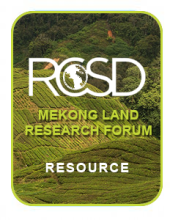/ library resources
Showing items 1 through 9 of 92.The forest landscapes of the Greater Mekong Subregion (GMS) are changing dramatically, with a multitude of impacts from local to global levels. These changes invariably have their foundations in forest governance.
In 2010, the Vietnamese government implemented a national payment for ecosystem services (PES) policy. In promoting the policy, the government has conveyed PES as a successful policy that has achieved multiple objectives, including forest protection and poverty alleviation.
This is a case about innovative approach of Boonrueng wetland forest conservation against land conversion for Special Economic Zone. Boonrueng wetland forest is the largest seasonal flooded forest in the Ing watershed located in the North of Thailand.
Forest landscape conflicts can be devastating on many levels – economic, environmental and social, from individual, to subnational, national and global levels. They are symptomatic of many issues revolving around weak governance. The problem is that seldom are they effectively addressed.
This study focuses on watershed management in Northern Thailand, where conflict over forest, land and water-use is a prevailing problem.
The Asia-Pacific region is a hotspot for forest landscape conflicts which are played out between local communities and outsiders such as government agencies and private companies.
This essay explores the changing landscape of food sovereignty politics in the shadow of the so-called ‘land grab’.
As a global phenomenon, land grabbing has significant economic, environmental, and social impacts, often resulting in serious conflict between the local community and outsiders.
Transforming conflict is a key component of sustainable forest management. Transformative conflict mediation is an approach to transforming conflict that aims not only to resolve the conflict but also to foster long-term relationships and cooperation.
Pagination
Land Library Search
Through our robust search engine, you can search for any item of the over 73,000 highly curated resources in the Land Library.
If you would like to find an overview of what is possible, feel free to peruse the Search Guide.

